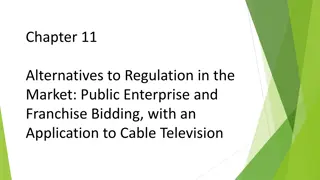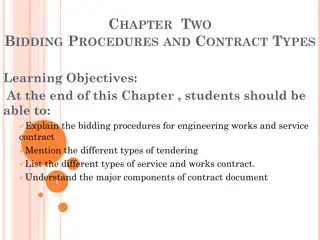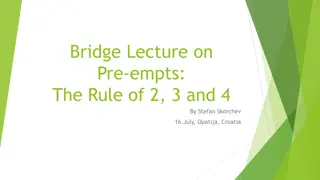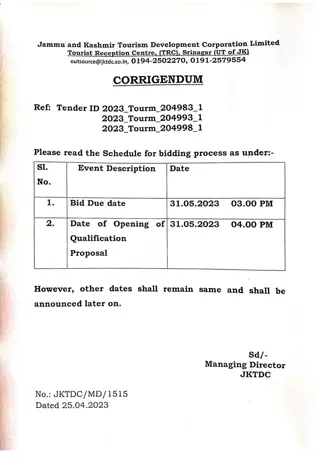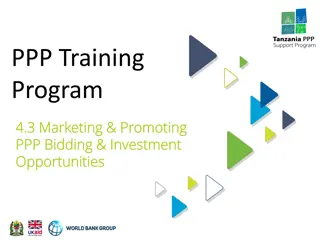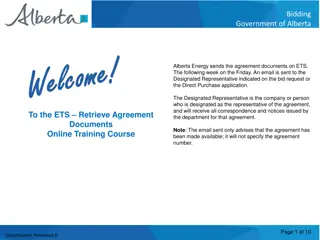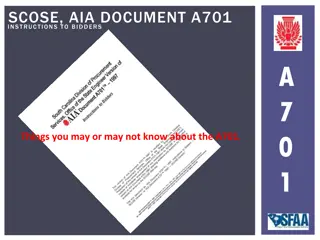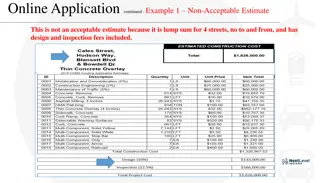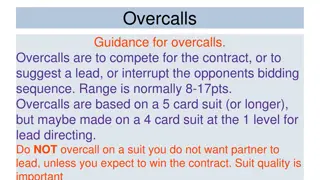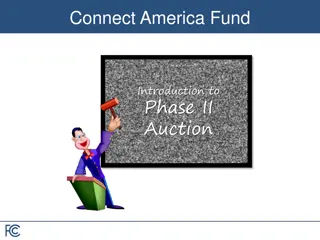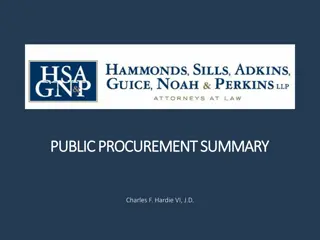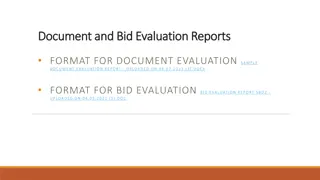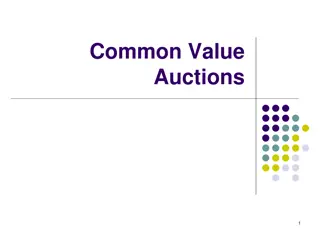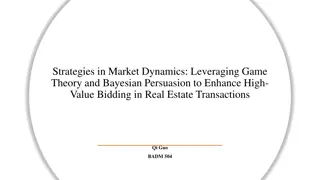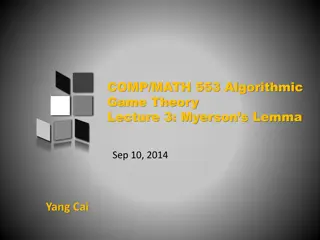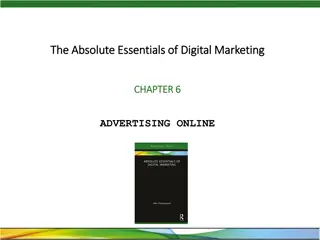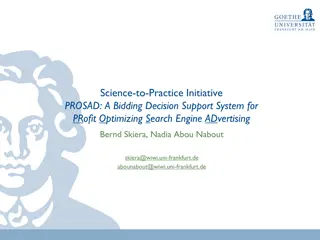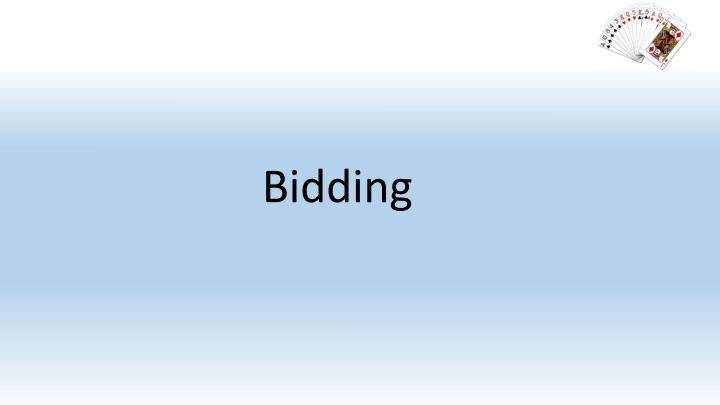
Mastering Bridge Bidding Strategies for Successful Partnerships
Learn how to effectively communicate and strategize in the game of Bridge, focusing on listening to your partner's bids, understanding signals, and making informed bidding decisions for a successful partnership. Explore the key elements of bidding, such as responding to weak bids, pre-emptive bids, club hand bids, and more, to enhance your gameplay and collaborative skills.
Download Presentation

Please find below an Image/Link to download the presentation.
The content on the website is provided AS IS for your information and personal use only. It may not be sold, licensed, or shared on other websites without obtaining consent from the author. If you encounter any issues during the download, it is possible that the publisher has removed the file from their server.
You are allowed to download the files provided on this website for personal or commercial use, subject to the condition that they are used lawfully. All files are the property of their respective owners.
The content on the website is provided AS IS for your information and personal use only. It may not be sold, licensed, or shared on other websites without obtaining consent from the author.
E N D
Presentation Transcript
Bidding Bridge is a game of PARTNERSHIP. You will never succeed unless you work together, understand each other , know what partner s bids mean, know how they play, and work together to achieve your contract or defeat the opposition. Bridge is unique compared to many other card games because it relies heavily on teamwork. Unlike games where individual players compete against each other, Bridge requires two players to work together seamlessly as a partnership to outwit their opponents. Bridge is as much about trust as it is about strategy. In this session we are going to look at: Listening to your partners bid. Listening to the opposition bids. Bidding a Weak 2 and response. Bidding a Pre-Empt 3- and response. Bidding a 2 Club hand and response.
Bidding Listening to your partner s bid. The cornerstone of effective communication in Bridge is understanding your partner s signals. Signals are the tools that partners use to convey critical information about their hands, intentions, and strategies. These signals range from bids to card plays during the game. Lots of partnerships use conventions when bidding. It is important that you both understand what conventions you use and how to use them. For instance: Do you use Stayman? at what level? do you both understand the responses? Do you use 4 card of 5 card major openings? Do you use 12-14 HCP for 1 NT or a higher point count? What do you bid if you have 19+ HCP Unbalanced? Your partner must know what is meant by your bids especially as they may get asked by the opposition!
Bidding Listening to your partner s bid. You must master the art of understanding how many points your partner has by the bids they make. To achieve a minimum GAME you need to have 25ish points between you, but first you have to find a Fit (for a trump contract). For example, If your Partner opens 11, and you have a fit in1, then think about the points. He has 12 HCP (or more), lets say you have 10 HCP. You know you should be in a contract but at what level? If your partner has more than 12 HCP, then maybe you can reach the 25 needed for GAME. So if you bid 2 or 3 1, it is saying to your partner, I have support but not enough for Game, if you have more than 12 then raise it to GAME. This is an Invitational Bid. If you use the Losing Trick Count, then you don t need to know how many points your partner has and the level of your responding bid is determined more accurately.
Bidding Explore Stop Define New Suits Choose Contract Limit Bid Opening 1 of a suit (Explore) Responder - If fit, support. Why change to a new suit if you have a fit? (Define) Opener Responder supported chose level. (Stop) Responder - Bid new suit (Explore) Opening NT usually Responder to choose final contract. Responder - 0-10 HCP no 5 card suit - Pass (Stop) Responder - Balanced? Should be in a NT contact (Define/Stop) Responder - 11+ HCP & 4 card Major use Stayman (Explore) (Define) Note- when you are sure of an 8 card Fit, you can count extra points for suit shortages: For a Void 5 points, for a Singleton 3 points and for a Doubleton 1 point.
Bidding Types of Bid you may have heard of/seen Forcing - A bid which tells partner that he must bid again. e.g. When Responder changes suit, when a convention is used such as Stayman, Transfers, Weak openings Invitational - Invites partner to bid again if he has a maximum hand. e.g. The sequence 1NT, 2NT is Invitational on Opener to bid 3NT if he has 13/14 HCP. Basically saying we are nearly at Game, but not quite, so if you have more points than I think you have, bid again (normally to Game). Conventional bid - A bid that has a special meaning and is not natural. e.g. An opening bid of 2cdoes not mean I have good clubs , it means I have 23+ HCP. A bid of 4cafter a NT opening does not mean I have good clubs it is asking partner how many Aces they have. Limit Bid - Has a small and precise point range including an upper limit to the number of points. A bid that tells everything in one bid. e.g. 1NT, it shows hand shape and a Limit of 12-14 HCP. A 1NT reply to an opening suit bid shows 6-9 HCP.
Bidding Listening to the Opposition s bids. As well as understanding what your partner has bid, it is important to understand the Opposition s bids. This will give you clues on what to lead, what kind of game they are in (can they make their contract easy or not), where their strengths are and where their weaknesses are. For instance: What was the response, positive? they have a fit in that suit. Negative, they are probably going for NT. Have they bid Stayman ? That would indicate that the bidder has 4 of a Major Have they bid a Transfer (did you ask?) that means the bidder has at least 5 cards in the Transfer suit. Have they bid a lot of the suits? If so they are probably weak and easier to defeat. What kind of hand have you got? If you are short (or non) in a suit it is a good chance your partner and the opposition have the same kind of hand. Have they given you a clue what to lead?
Bidding A few tips Remember in tournament bridge, you get as many points for making a 1 level bid and 2 overtricks as biding a 3 level contract. If your partner opens with a suit, ALWAYS respond if possible as he may have wanted to have another bid, to bid NT with more than 14 HCP. Of course if the opposition has overcalled, he gets another bid anyway. If you are on the margin, say 24 HCP between you and at the 3 level, go the extra bid to GAME, you will be surprised how many times you will make that extra trick. Consider going that extra mile and avoid playing in 3 of a Major, 4 of a Minor or even 2NT. Go for it (but see next point)! Be aware of the Vulnerability especially if you are taking a chance on your bid! Try to avoid playing a Contract in a Minor suit, better to consider NT instead. You ned to know the Contract points count off by heart!
Bidding Combined HCP for you and Partner 19-24 HCP 25+ HCP 31+ HCP 33+ HCP 35+ HCP 27+ 37+ HCP HCP Enough for SLAM (7NT). Check Aces and Kings with Blackwood/ Gerber Enough for part score. (1NT, 2NT, 3 in Suit Enough for small SLAM (6NT). Check Aces with Blackwood/ Gerber Enough for 5 in Minor Suit. Enough for 4 in Major Suit or 3NT Enough for small SLAM (6 in suit). Check Aces with Blackwood/ Gerber Enough for SLAM (7 in suit). Check Aces and Kings with Blackwood/ Gerber
Bidding A few tips In competitive auctions, where both sides are bidding, your combined trump length is a good indication of how high you should be bidding. For that reason, showing your suit length as quickly as possible with an overcall or double helps partner to make better bidding decisions. The better your trump fit, the higher you should be competing. 8 trumps between the 2 hands = bid for 8 tricks 9 trumps between the 2 hands = bid for 9 tricks 10 trumps between the 2 hands = bid for 10 tricks Partner opened 11, What would you respond with these? (a). Bid 4 . You have an eight-card heart fit and the values for game (25+ partnership points). (b). Bid 2 . Your 2 bid classically shows 6-9 points. Your great support easily compensates for the lack of a sixth high-card point. (c). Bid 1 . You may not have a heart fit, so introduce spades. It s entirely possible partner has 41and 4s and that spades is your trump suit.
Bidding Weak 2 (5-10 HCP) A weak 2 bid can be very useful for taking away bidding space from the opposition, especially if it is in a Major, however: It can also be very difficult to win, so the Vulnerability should also be considered here. It is essential that you agree with your partner how you are going to use the Weak 2 bid. My partner does not like playing Weak 2s (we have failed so many times!), so we use the following rules: Need a 6 card suit. Only bid a Weak 2 in Majors, it isn t worth the hassle in a 2 suit. Only bid if you have 2 of the top 3 honours OR 3 of the top 5 (including the 10) We also use a strict rule about responding when your partner has bid a Weak 2: If you have 0 -13 HCP: 2 card support, Pass. 3 card support, raise the bid by 1. 4 card support. Raise the bid by 2 (to GAME). If you have 14+ HCP: Bid NT.
Bidding Pre-Empt 3 (6-9 HCP) This Pre-empt could be described as: Making a high-level bid with a weak hand and a long suit with the objective of causing problems for the opponents You need 7+ cards in a suit, but the same considerations still need to be made as for the Weak 2 bid. Consider if it is worth bidding in a Minor 7 card suit. Only bid if you have 2 of the top 3 honours OR 3 of the top 5 (including the 10) Responding when your partner has bid a Pre-Empt 3 level bid: If you have 0 -15 HCP: 2 card support, Pass. 3+ card support, raise the bid by 1 (to GAME). Be very careful biding NT unless you have stoppers in the other suits as you partner probably doesn t have good outside suits. With 16+ points you are better bidding GAME in partners suit or bidding a new suit.
Bidding 2c Bid (23+ HCP or 10 playing tricks) This bid is used to indicate that you have a very high points count (23+HCP) and you need little support from your partner to achieve GAME. What you do need, however, is to know the shape of your partners hand so you can decide what is the best Contract. The pressure is on the Responder here to describe their hand to the Opener, so the responses are: 0-7 HCP bid 22. This tells your partner you have a low HCP count and cannot support him. 8+ HCP OR any 1 Ace AND 1 King, bid your best suit. Your partner will then decide what the best option is depending on the shape of his hand.
Bidding Don t forget there is lots of useful information and videos on our web site: www.bridgewebs.com/hcbridgeclub Let Play!


